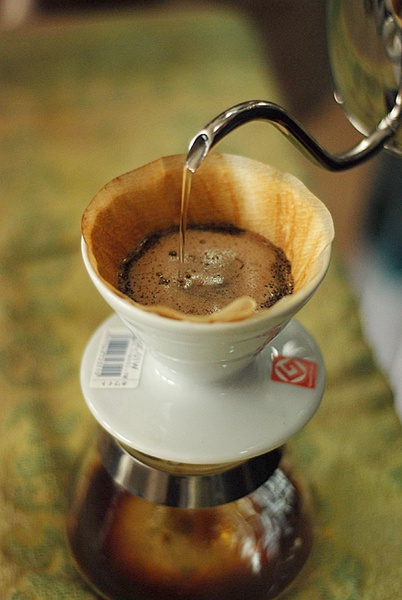The factors affecting the quality of Espresso are called variable coffee. The effect of variable factors on the quality of coffee.
Chapter III Environmental Factors--Temperature, Sunshine and Humidity
What is "variable cause"
In the process of brewing espresso, factors that affect the quality of espresso are called variables. Some variables are caused by different skills of "people," and some variables are not easy to control, such as the environment of nature, which is always changing all the time. In the face of these uncertainties, bar staff must maintain flexibility to adjust the brewing method at any time to maintain consistent quality.
God is unpredictable.
I started my business in 1988 as a street vendor. I soon discovered that cooking espresso outdoors was much more affected by weather than cooking it indoors. If the temperature is low and the humidity is moderate (relative humidity 50~60%), it is easy to make, and the ground coffee can be placed for 4 minutes without affecting the flavor. However, it is important to note that ground coffee is as troublesome as the weather. The oxidation begins the moment the beans are ground into powder.
Coffee goes stale faster in hot weather. Coffee grinds faster! Whether it's heat, dry air, or direct sunlight hitting the beans, it's espresso's nightmare. Because such an environment will make the water in the beans quickly lose during the grinding process. The escaping water molecules take away the aromatic ingredients in the beans, and the brewed coffee tastes much worse.
Of course, it is impossible to cover everything, but it is helpful to pay attention to a few details:
Grind only enough coffee powder at a time, don't grind too much and save the rest for the next cup.
The lid of the bean grinder should be covered and sealed with electrical tape.
Put coffee powder and compaction action should be rapid and accurate, so that dry air without gaps.
Inside the shop, we found that the best way is to grind only when there are customers, and only grind enough for this cup.
Even with all this care, you can cook great espresso on a cool october day-but it's hard to do the same outdoors in august. The only way to cook an espresso that experts appreciate is to hide indoors. Because the indoor environment is better controlled, the stall-style cooking method will probably be phased out gradually. "High temperatures" and "low humidity" (Web Barista adds insult to injury: America is drier, and often you get electrocuted when you open your car door. Taiwan is afraid to worry about humidity is too high...) It can be fatal for coffee.
So what do we do?
When buying beans, buy them a few times, about once every five days. Store stored beans in a sealed basement or in a cool place. (More on freshness later.)
Here's what we did at our stand outdoors in Seattle in August: We put two cups of beans at a time (it took about 15 minutes to use), and while the beans were waiting in the hopper above the grinder, we lined the hopper with a piece of white paper to keep the sun out of the beans and to block out some of the heat, and I loved the beans.
Baby! It's cold outside!
When it's cold, brewing coffee outdoors can also be a challenge. All espresso machines expose the outlet head, filters and handles because the filters cool faster. These metal parts dissipate heat easily. Although espresso machines are designed to keep these critical temperatures constant. (Of course, the path from the liquid down to the cup should also be included.) In winter, temperatures still drop 10 degrees.
To solve the problems caused by low temperature, it depends on some common sense:
Keep the handle locked over the spout as long as possible to keep it warm (don't dangle the handle while farting with customers). All movements must be "quick! Hurry! Hurry! "Grind the coffee, tap off the residue in the handle quickly, and immediately fill it with fresh coffee powder. The shorter the duration, the less the cooldown.
Preheat the handle and spout. While grinding the coffee powder, start the pump to run hot water through the handle and used coffee powder. Be careful not to use more than 2 ounces of hot water to avoid upsetting the thermal balance of the machine and lowering the water temperature.
Moisture is the culprit.
Ground coffee powder is highly hygroscopic and absorbs moisture when the ambient temperature is relatively high. When the ambient temperature is relatively low, it releases moisture. If the environment is very humid, the packing will be tighter, reducing the extraction rate. Therefore, espresso should be cooked according to the time.
When brewing espresso, we pay great attention to how much water passes through the coffee cake per second. Espresso's "golden law of flow rate" states: "extraction time is about 25 seconds, whether single or double dose." This allows you to extract the most delicious ingredients while at the same time extracting the least amount of caffeine and unpleasant substances. (As long as the single-dose sieve is the same shape and depth as the double-dose sieve, the optimal extraction time will be the same.)
The method used in my shop to control the "25 second extraction time" is to adjust only the grinding thickness (dosage and packing are also kept constant to reduce variables), keeping all other variables constant.
Coffee is very sensitive to moisture, and we train bar staff to fine-tune it according to extraction time, even when moist air from the sea blows in, each cup needs to be adjusted.
Adjust the tone of the violin
When cooking espresso, keep the filling weight and dosage unchanged, only change the thickness of the grind.
As moisture increases, coffee absorbs moisture, packs it tighter, and resists water pressure. In order to maintain the "25 second extraction time," adjust the grinding to a coarser degree at this time.
When the moisture is reduced, adjust the grind a little bit.
Of course, we're not making coffee while staring at a hygrometer. All of this just to tell you why the extraction time of coffee changes constantly within the same day.
Think of yourself as a musician adjusting the tone of a violin: adjusting the body to subtle changes in ambient temperature and humidity. That resonates beautifully.
Espresso Coffee: Professional Techniques 1996 Edition
Source: Bolan Coffee College
Important Notice :
前街咖啡 FrontStreet Coffee has moved to new addredd:
FrontStreet Coffee Address: 315,Donghua East Road,GuangZhou
Tel:020 38364473
- Prev

The best water temperature for hand-brewing coffee absolutely affects the quality of a cup of coffee.
(Ⅶ) Chapter 7 brewing water temperature-the elements of good coffee water temperature control is good or bad, absolutely affect whether a cup of coffee can preserve the delicious substances in the beans. The better your coffee is made, the more intractable the ultimate problem of water temperature becomes. The water temperature seriously affects the quality of coffee, but it is difficult to control. The temperature of the water is not good, because the temperature of the boiling water in the espresso machine is higher than that of the machine.
- Next

The aroma components of coffee are easy to dissipate. How to preserve the best aroma quality of coffee?
The aroma components tend to dissipate the rich aroma of fresh coffee when ground, inspiring poets for hundreds of years. In order to capture these aromas in coffee cups, all kinds of beautiful shapes and strange coffee machines have come out one after another, thus achieving this arduous super task. Why is it so difficult to make brewed coffee as fragrant as freshly ground coffee?
Related
- What is the meaning of lactic acid fermentation with coffee bean treatment?
- How to judge the state of foam by sound?
- How does the latte pull out the unicorn pattern? Come to get for a little trick to improve the flower pull!
- Will flower pulling affect the taste of the latte?
- Do you know the history of coffee?
- The difference between honey treatment and sun washing what is raisin honey treatment?
- What kind of milk can a novice use to make coffee foam to keep the foam longer? The correct method and skills of milking tutorial sharing
- Why do washed coffee beans taste sour? Flavor characteristics of washed Coffee
- Introduction to the skill of how to practice the size and height of water injection around the circle of hand-brewed coffee
- How do beginners practice coffee flower drawing from scratch?

